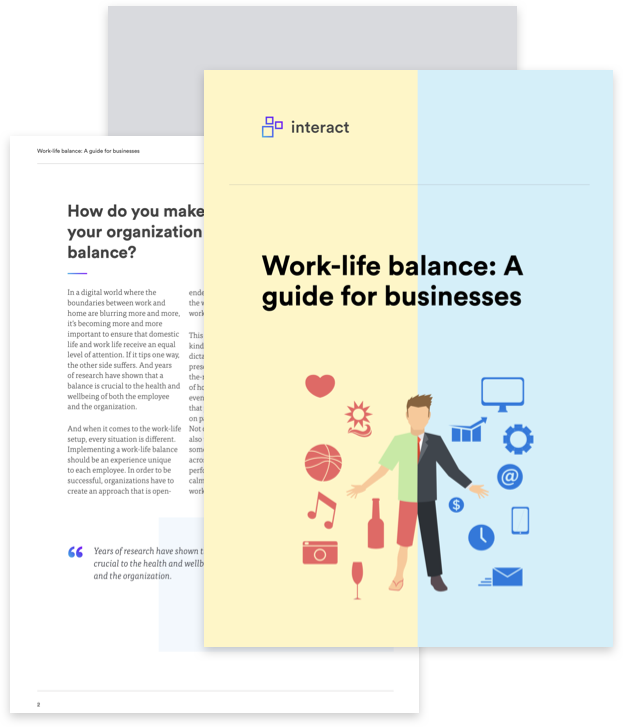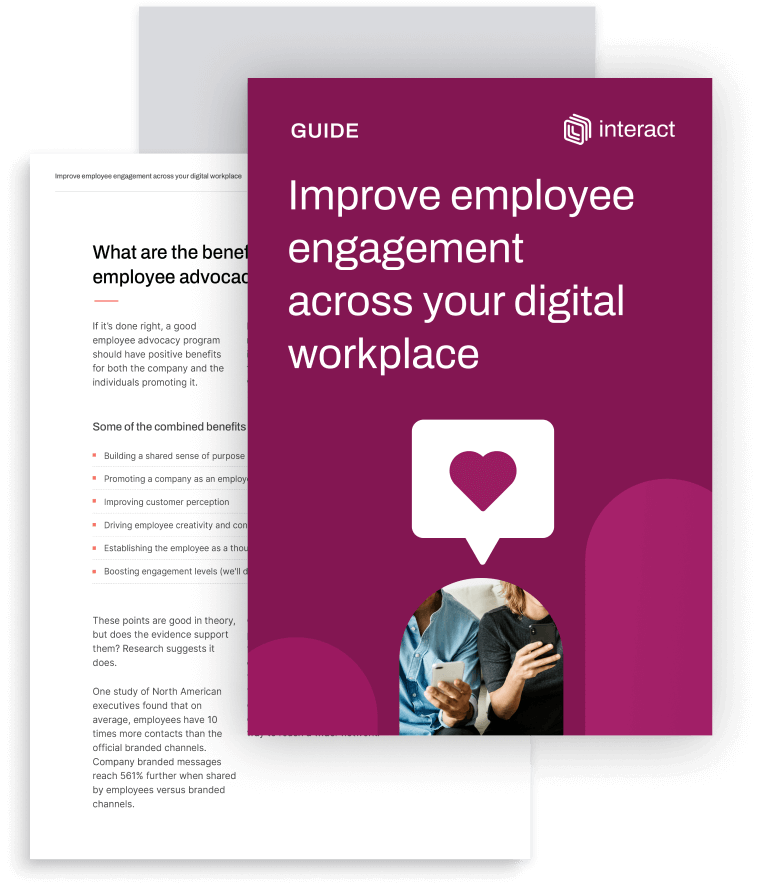10 Ways to Improve Employee Satisfaction in Your Business
A business is only as good as its people. With staff retention, productivity and engagement now ranking as the most topical concerns for modern-day businesses, identifying ways to improve and build job satisfaction for employees must be on the company agenda in order to ensure continued success.
What is employee satisfaction and why does it matter?
For Human Resources expert, Susan Heathfield, the definition of employee satisfaction is one which describes:
“Whether employees are happy and contented and fulfilling their desires and needs at work.”
Why does job satisfaction matter then? Heathfield argues,
“Employee satisfaction is a factor in employee motivation, employee goal achievement, cost savings, customer satisfaction, employee productivity, positive employee morale, and more in the workplace.”
Aside from the impact that job satisfaction has on individual and team performance, there is also a clear effect on organizational success too. Dissatisfied employees are disengaged employees, and workplace disengagement is causing major losses for companies worldwide. In 2022, Gallup suggested that only 21% of employees were engaged, causing $7.8 Trillion in lost productivity, the equivalent of 11% of global GDP.
Many organizations now take the view that positively improving job satisfaction and increasing employee engagement can bring significant benefits for company culture, productivity, and profitability.
Which factors influence job satisfaction?
Contrary to popular belief, financial compensation alone has a limited impact on job satisfaction. In a recent survey on what makes employees happy at work, Indeed.com found that pay ranked last on the list of things that increase job satisfaction.
Instead, the research pointed to factors beyond salary alone, including company culture or values, career opportunities, and leadership.
According to Indeed’s Workplace Happiness Report, these are just some of the factors driving employee happiness.
- Feeling energized by work
- Feeling like they belong
- Having a sense of purpose
- Achieving goals
- A culture of inclusion
When looking to address employee satisfaction and morale, what practical steps can managers, HR professionals, and leadership take?
Communicating with Gen Z employees
How to improve job satisfaction in your workplace
1. Be flexible
Giving employees greater control, autonomy, and responsibility for their own time within the workplace (and externally) is paramount. With the rising popularity of work-life balance as an employee demand, particularly amongst the Millennial generation, empowering employees with flexible work schedules and the option for telecommuting according to individual needs is a key first step. Being open to staff coming in and leaving earlier or later also addresses the stress of the daily commute.
2. Allow employees to shape their own roles
Individuals who have the opportunity to shape their own roles and work according to their strengths also demonstrate greater job satisfaction. Regular job reviews that allow the opportunity for employee feedback and encourage a proactive approach to role development address this need; however, managers will need to exercise judgment in aligning an individual’s wishes with the greater needs of the business.
3. Stop micro-management
Support middle management in achieving a balance between supporting their teams and stepping over into the dangerous territory of micro-management. Evidence against the practice shows managers who persistently make all the decisions, are unable to delegate, and tend to assert their authority at will just ‘because they can’ create a negative culture for employees: resulting in low morale, lack of employee innovation, disengagement, and, ultimately, high staff turn-over.
Essential guide – 14 steps to amazing internal communications!
4. Recognize and reward – outside financial remuneration
Employees need to know that their work and performance are both recognized and valued. Deploy recognition processes, whether that be a company-wide intranet announcement, internal newsletter, or a staff meeting, to ensure hard work is celebrated. Consider the ‘smaller’ yet equally significant perks your staff may appreciate: whether that be vouchers, a day’s additional holiday, a lie-in, ad-hoc gifts, or simply use of the best parking slot for the month. Set stretching yet achievable targets employees can aim towards and strive for.
5. Drive communication and transparency
When change occurs within the workplace, dissatisfied employees are those who feel they haven’t been kept informed. The result is disengagement and the potentially poisonous spreading of rumors and false information.
Adopting a transparent approach to keeping employees informed is essential. Using internal communication tools or platforms such as intranet software, company emails, newsletters, manager cascade meetings, or ‘town hall’ announcements, ensure your staff is in the know. Communication should also be a two-way process: adopt an open-door policy to invite feedback and encourage a collaborative culture in which employees feel they are heard and their opinions respected.
6. Promote good health
Looking after employee health is no longer the sole responsibility of the individual; due to the significant cost to employers, it now lies with organizations to promote and drive good health. Workplace stress is attributed to $190 billion in US healthcare costs (Joel Goh, The Relationship Between Workplace Stressors and Mortality and Health Costs in the United States) and causes associated health concerns including hypertension, high blood pressure, gastrointestinal issues, fatigue, and substance abuse.
Organizations can support employees by educating them on health issues through materials or seminars, ensuring staff take regular breaks and annual leave, providing kitchen facilities and healthier food choices in-office, and offering discounted gym memberships or company communities for weight-loss or fitness goals – for example, having employees complete a race together for charity or similar.
7. Look after the work environment and housekeeping issues
Small things make a big difference. Employees are more likely to be disgruntled if they are regularly using sub-standard facilities or facing frustration caused by slow servers, insufficient software, or broken equipment. Deal with staff complaints swiftly and embed reporting processes to identify issues. Additional personalized touches to the office, whether that be pictures on the walls or a full-scale Google slide, will create an atmosphere that will engage employees and improve their perception of coming to work. Allowing employees to take responsibility for their own workspace and apply small individualized touches will embed a sense of belonging and support job satisfaction.
Work-life balance: A guide for businesses
8. Training and investment
Support your employees in striving for more and drive their career development. Investing in employees by offering training, up-skilling, mentoring, or coaching is proven to enhance their satisfaction and engagement with the business. As an employer, you not only benefit from happier employees but the additional skills and expertise they are subsequently able to offer.
9. Embed a strong, sociable culture
According to a Gallup poll, close friendships at work improve employee satisfaction by as much as 50%. Creating a strong company culture isn’t achieved overnight; however, employers can help facilitate its development by encouraging socialization and communication.Intranet software that embodies social tools and encourages collaboration is a key driver in achieving this, particularly for workforces that are not centralized in one location – a growing theme with globalization. Consider the workplace environment and whether colleagues can talk and share ideas. Organized social activities outside of work hours are beneficial; organizations that encourage birthday celebrations or attend events together demonstrate greater engagement and contentment at work.
10. Reduce bureaucracy, red tape and time-wasters
As organizations expand, processes must evolve to allow for the change. Failure to adapt will result in frustrations and time wasted as individuals wait for the red tape. Is it really essential for your CEO to personally approve every PO? Can your processes be streamlined, automated, or assisted, perhaps through the implementation of a company intranet system that digitalizes HR processes or provides a centralized point for communication and collaboration.
Finally, look at the greatest time-stealers within your business. Meetings rank as one of the biggest causes for lost time: an average of 31 hours wasted every month,according to Atlassian, which estimates the cost to US businesses at a staggering $37 billion annually. Of those surveyed, 91% confessed to daydreaming, while 45% felt overwhelmed by the number they attended. Removing time-wasters relieves stress and anxiety, increases productivity, and drives employee satisfaction in the workplace.
Happier employees make for a more productive, innovative, and engaged workplace. By even implanting small changes to improve employee satisfaction, organizations will benefit from significant long-term rewards. Why not try and see what you could do to support your employees today.




